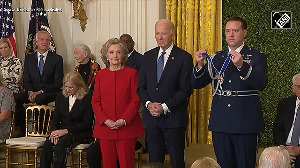The poor are clearly a business opportunity for any sector, including banks, speakers at a session on agriculture and micro financing at the Federation of Indian Chambers of Commerce and Industry conference on "Global banking: paradigm shift" said on Wednesday.
R V Shastri, chairman and managing director, Canara Bank, said, "Financing self-help groups has proved beyond doubt that poor are bankable."
"While the concept has established itself as a collateral substitute, it has also reached a critical mass by crossing the Rs 3,000 crore (Rs 30 billion) mark," he said.
Further, banks can now step into it boldly as this model has constantly ensured 90-95 per cent recovery rates, he added.
Despite the micro credit movement and organised banking penetration, the rural reach reflects just the tip of an iceberg speakers said.
For instance, Sonal Shah, director and head, strategic advisory, food and agri business, Rabo India Finance, said, "Although the Indian rural economy accounts for over 23 per cent of the GDP, it's share in the total deposits stands at around 14.6 per cent. The need of the hour is to unshackle agri business sector by enhancing priority sector lending, organised rural retailing, level playing fields for agro processed food brands with their unbranded peers and also by creating a demand pull for credit".
She suggested the adoption of a low-cost delivery structure, integration of co-operative banks under an apex structure to leverage on the local knowledge, propping up of farmer processor linkages/supply chain integration as in the orange juice industry in Brazil besides income support for farmers through means like insurance subsidy that do not affect the supply chain financially like a minimum support price.
She also recommended an all-finance concept similar to European banks to include the gamut of banking and financial services.
Zarin Daruwala, head, agri-business group, rural and micro banking group, ICICI Bank, said supply chain linkages will be the way forward.
However, innovations needed to be tagged on to such linkages to ensure benefits to banks, she said.
She added that banks can leverage on existing channels like co-operative banks, micro-finance organisations, corporate, besides low cost transaction points like kiosks to service the rural areas.
Fakhruddin Ahmed, governor, central Bank of Bangladesh said micro-finance in Bangladesh had reached 11 million of the 13 million poor population (representing 50 per cent of the 26 million in the country).
This comes besides poverty alleviation has empowered women and their social status, he said. The success of this mode in Bangladesh can be measured from the fact that annual disbursements have crossed $1.5 billion, with member's savings alone accounting for 36 per cent of this, he said.
The challenge now, he said, was to prop up a regulatory framework to contend with the sheer size of the movement.
He added that Bangladesh was now trying to form a legal framework to regulate micro-credit organisations without affecting the character of the movement.





 © 2025 Rediff.com -
© 2025 Rediff.com -